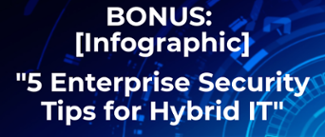 Even as employees return to the office, just as many are choosing to stay remote. As a result, many enterprises need solutions that can provide specialized security for remote workforces.
Even as employees return to the office, just as many are choosing to stay remote. As a result, many enterprises need solutions that can provide specialized security for remote workforces.
Unlike in an office setting where IT can effectively control the who, what, when, where, and why of device usage and network access, remote workforces present unique challenges. To keep corporate data secure, these challenges must be addressed with strategies that have been developed with remote workers in mind.
Remote work environments also require cloud-based security, an additional challenge when selecting the perfect solution. The benefit is that cloud adoption makes all your security controls, including network, email, endpoint, identity, access management, authentication, and others “follow” remote employees wherever they go, rather than remain confined to an often irrelevant on-premises environment.
Three Areas To Address For Remote Workforces
While security is always a priority for enterprise IT, there are several specific areas of concern that must be addressed when it comes to ensuring security for a remote workforce.
These areas of concern can be broken down as follows:
- Email security – Today’s enterprises are dependent on email for communication. In a remote working scenario, especially when it’s unexpected, email can become the primary way employees share important and oftentimes confidential information or documents. As a result, email is frequently targeted by cybercriminals and should be prioritized when it comes to security for remote workforces.
- Device security – When employees are working from home or other remote locations, the security of their devices should be carefully considered. Not only is it important to ensure that devices cannot be accessed by those without the proper login credentials, it’s equally important that employees know what they can and cannot use their devices for.
- Insider threats – One of the largest threats to enterprise security comes from within. Employees that lack the proper training to spot cyberattacks or who are unclear of the security risks that certain behaviors create offer cybercriminals an easy way past your security.
How To Address Areas Of Concern With Mimecast
Enterprises in need of security solutions created with remote workforces in mind need look no further than Mimecast. Offering cloud-based email security, security awareness training, and web security, Mimecast can help enterprises secure their environment and prevent cyberattacks from succeeding.
Mimecast’s cloud-based Secure Email Gateway offers protection for employees using any cloud or on-premises email platform and defends against spear-phishing, whaling, malware, spam and other attack types. By combining custom applications and policies with multiple detection engines and intelligence feeds, Mimecast offers the first line of defense for email-dependent enterprises.
When it comes to online activity outside of email, Mimecast’s cloud-based web protection at the DNS level prevents malware attacks and inappropriate web use regardless of whether employees are at the office or at home. It also helps mitigate shadow IT risks from cloud app usage. Best of all, it integrates with Mimecast’s email security for consistent cyber protection.
Should an employee still somehow encounter a cyberthreat, Mimecast offers the training they need to learn how to spot suspicious activity and respond appropriately. Mimecast’s security awareness training reduces the risk of human error and helps IT minimize the impact of insider threats by adding an extra layer of protection against cyberattacks.
Long term remote work causes the lines to blur between home and work life for many employees, but with Mimecast’s security awareness training, you can positively impact security culture throughout the enterprise and help employees internalize critical cybersecurity concepts that help keep your data safe.
Want to learn more about Mimecast’s Security Solutions?
Mimecast helps companies protect their employees, intellectual property, customer data, and brand reputations by providing comprehensive, cloud-based security and compliance solutions that mitigate risk and reduce the cost and complexity of creating a cyber-resilient organization. It is an ideal option for hybrid workforces now and into the future. If you have questions about hwo to get started with Mimecast, contact WEI today.
NEXT STEPS: How we secure our enterprise has changed drastically i less thna one year, especially for those managing a much larger network of devices and remote workers. Find out what your security strategy might be missing with our tech brief below, "5 Best Practices to Secure Your Hybrid Workforce."











